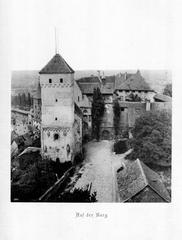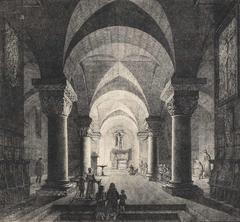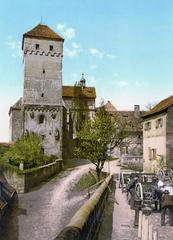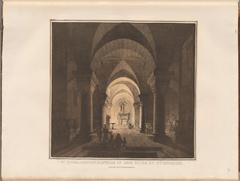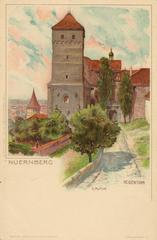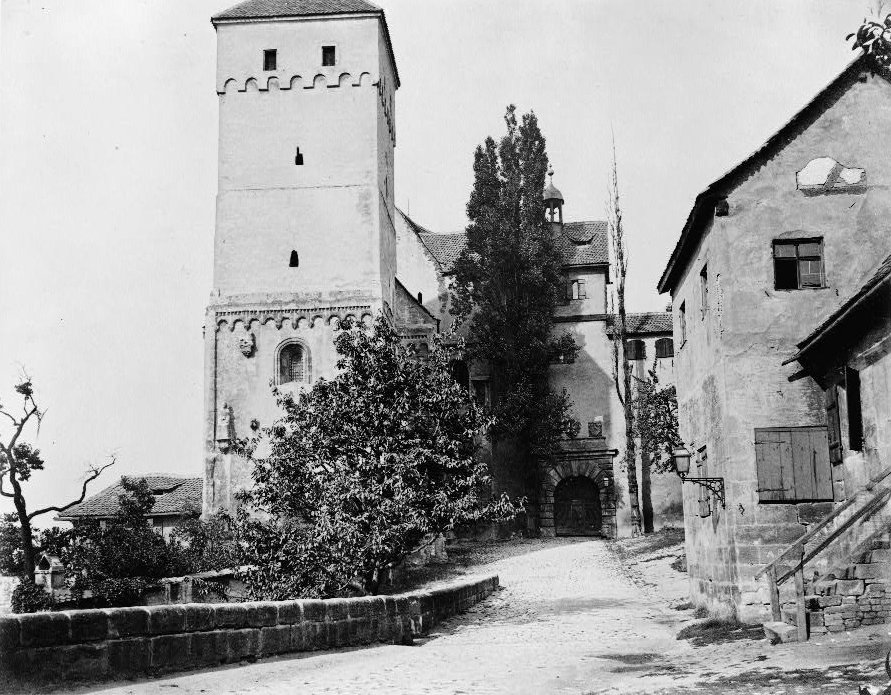
Burgkapelle Burg 16: Imperial Chapel Visiting Hours, Tickets, and Historical Significance in Nuremberg, Germany
Date: 14/06/2025
Introduction
Burgkapelle Burg 16—commonly known as the Imperial Chapel (Kaiserburgkapelle) or Double Chapel (Doppelkapelle)—is one of Germany’s most fascinating medieval sites. Located within the formidable Nuremberg Castle (Kaiserburg Nürnberg), this architectural treasure offers visitors a rare look into the religious, political, and social life of the Holy Roman Empire. With its unique two-level design, rich imperial history, and carefully preserved Romanesque features, the Burgkapelle stands as a testament to the enduring legacy of the Middle Ages in Nuremberg.
This comprehensive guide provides everything you need to plan your visit: historical background, architectural insights, current visiting hours, ticket information, accessibility details, travel tips, and answers to frequently asked questions. Whether you are a history enthusiast, architecture lover, or cultural traveler, the Imperial Chapel is a must-see highlight in the heart of Nuremberg’s Altstadt.
For the latest updates and planning resources, consult the Kaiserburg Nürnberg official website and Nuremberg’s tourism portal.
Table of Contents
- Historical Background and Architectural Significance
- Imperial and Religious Importance
- Artistic Features and Notable Artifacts
- Surviving Conflict and Restoration Efforts
- Visiting Hours, Tickets, and Accessibility
- Guided Tours and Audio Guides
- Travel Tips and Nearby Attractions
- Special Events and Visitor Experience
- Frequently Asked Questions (FAQs)
- Conclusion and Call to Action
- References
Historical Background and Architectural Significance
Romanesque Double Chapel Design
Dating to around 1200 CE, the Burgkapelle is an outstanding example of Romanesque architecture in southern Germany (Wikipedia: Nürnberger Burg). Its most distinctive feature is the double chapel layout: two superimposed chapels with identical floor plans, physically expressing the strict social hierarchy of medieval Europe. The lower chapel was reserved for castle staff and lower-ranking visitors, while the upper chapel was designed exclusively for the emperor and his court, accessible via a separate staircase and imperial gallery (Kaiserburg Nürnberg).
Key architectural highlights include rounded arches, robust stone construction, thick walls, and minimal but refined decoration. The eastern choir tower—known as the Margarethenturm or Heidenturm (“Heathens’ Tower”)—features late Romanesque decorative elements and forms a prominent part of the castle’s silhouette (Wikipedia: Nürnberger Burg).
Integration with the Castle Complex
Strategically positioned next to the Palas (main residential building) and the Heathens’ Tower, the chapel’s placement underscores its importance as both a spiritual center and a symbol of imperial authority. The castle complex itself served as a critical administrative, military, and residential site for the Holy Roman Empire (ilikegermany.com).
Restoration and Preservation
After suffering significant damage during World War II—when much of Nuremberg was devastated—the Burgkapelle was carefully restored, using historical records and original materials wherever possible (Historisches Lexikon Bayerns). The removal of 19th-century plaster in the late 20th century revealed original stonework, reflecting a commitment to historical authenticity.
Imperial and Religious Importance
For centuries, the chapel was the spiritual heart of Nuremberg Castle, where German kings and emperors worshipped and participated in imperial ceremonies. The double chapel design was not only functional but also symbolic, physically reinforcing the divine right and elevated status of the emperor (travelyesplease.com). The upper chapel’s imperial gallery allowed the monarch to participate in religious services while remaining distinct from the rest of the congregation.
The Burgkapelle’s location and use highlight Nuremberg’s role as a major seat of power in the Holy Roman Empire, frequently hosting imperial assemblies and safeguarding the imperial regalia (History Tools).
Artistic Features and Notable Artifacts
While many original medieval furnishings and artworks were lost over time, the upper chapel retains a remarkable late Gothic crucifix attributed to Veit Stoß, one of Germany’s greatest Renaissance sculptors (Wikipedia: Nürnberger Burg). Surviving Romanesque capitals, arcades, and the emperor’s gallery continue to impress visitors with their craftsmanship and ceremonial function (travelyesplease.com). Some capitals display intricate carvings, and the space’s verticality is designed to inspire awe.
Surviving Conflict and Restoration Efforts
The Burgkapelle has endured centuries of conflict, including the Thirty Years’ War and extensive destruction during World War II. Remarkably, the chapel itself survived largely intact, making it one of the few original structures in the Nuremberg Castle complex (Wikipedia: Nürnberger Burg). Post-war restoration prioritized the preservation of Romanesque and Gothic elements, ensuring the chapel remains a central, authentic part of the castle experience (Kaiserburg Nürnberg).
Visiting Hours, Tickets, and Accessibility
Opening Hours
- April – September: 9:00 AM – 6:00 PM (daily)
- October – March: 10:00 AM – 4:00 PM (daily)
- Closed: January 1, Shrove Tuesday, December 24, 25, and 31
For up-to-date information, check the Kaiserburg Nürnberg website.
Tickets and Admission
- Combination Ticket (Palas, Double Chapel, Museum, Deep Well, Sinwell Tower): €9 regular, €8 reduced
- Palas with Double Chapel + Museum: €7 regular, €6 reduced
- Children under 18: Free
- Castle Gardens: Free
Tickets are available at the castle’s outer courtyard cash desk (cash or card). Online ticket sales are not currently offered.
The NÜRNBERG CARD provides free entry to multiple museums, 50% activity discounts, and free public transport for 48 hours—ideal for extended stays.
Accessibility
- The lower chapel is generally accessible, but the upper chapel requires stairs.
- The castle’s hilltop location and historic architecture mean some paths are steep or uneven; wheelchair access is limited.
- For accessibility inquiries, contact the castle administration or visit the official accessibility page.
Guided Tours and Audio Guides
- Self-Guided Visits: The Palas, Double Chapel, and museum can be explored independently.
- Audio Guides: Available in seven languages for €2 per device.
- Guided Tours: The Deep Well is accessible only via guided tour (hourly demonstrations). Special group tours for the Palas and Burgkapelle can be arranged by appointment.
Travel Tips and Nearby Attractions
- Best Time to Visit: Early morning or late afternoon to avoid crowds.
- Combine Your Visit: Tour the Sinwell Tower for panoramic city views and the Deep Well for a sense of medieval defense.
- Photography: Non-flash photography is allowed in the chapel. The Freiung platform and Sinwell Tower provide excellent photo opportunities.
- Nearby Attractions: Explore Albrecht Dürer’s House, St. Sebaldus Church, and the Historic Mile of Nuremberg (Road Affair).
Amenities
- Restrooms and a café are located on-site.
- The castle gift shop offers books, souvenirs, and replica artifacts.
Special Events and Visitor Experience
The Burgkapelle occasionally hosts medieval-themed concerts, reenactments, and seasonal events that bring history to life. Audio guides and special exhibitions provide deeper insight into the chapel’s history and architecture (travelyesplease.com).
Frequently Asked Questions (FAQs)
Q: What are the Burgkapelle visiting hours?
A: April–September, 9:00 AM–6:00 PM; October–March, 10:00 AM–4:00 PM. Closed on select holidays.
Q: How much do tickets cost?
A: Combination tickets are €9 regular, €8 reduced. Children under 18 enter free.
Q: Is the Burgkapelle accessible for people with disabilities?
A: The lower chapel is accessible, but the upper chapel requires stairs. Some castle areas are steep or uneven.
Q: Are guided tours available?
A: Yes—audio guides in multiple languages and guided tours for some areas (such as the Deep Well and group tours for the chapel).
Q: Can I take photos inside?
A: Non-flash photography is permitted. Tripods may be restricted.
Conclusion and Call to Action
Burgkapelle Burg 16 is a living monument to Nuremberg’s imperial past, combining architectural splendor, historical depth, and a vibrant visitor experience. Whether you seek medieval history, stunning Romanesque stonework, or panoramic views over the Altstadt, a visit to the Imperial Chapel is a highlight of any Nuremberg itinerary.
To enhance your visit, download the Audiala app for interactive audio guides and up-to-date information, and follow us on social media for more travel inspiration. For detailed planning, consult the official Kaiserburg Nürnberg website and Nuremberg Tourism.
References and Further Reading
- Wikipedia: Nürnberger Burg
- Kaiserburg Nürnberg official website
- ilikegermany.com
- travelyesplease.com
- Historisches Lexikon Bayerns
- History Tools
- The Geographical Cure
- Tourist Information Nürnberg
- Tourismus Nürnberg
- Road Affair

